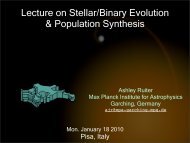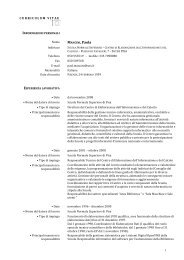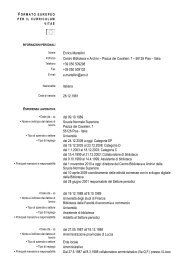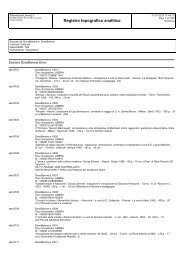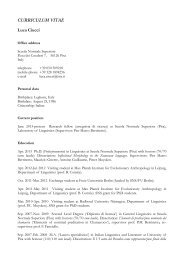Metrics of curves in shape optimization and analysis - Andrea Carlo ...
Metrics of curves in shape optimization and analysis - Andrea Carlo ...
Metrics of curves in shape optimization and analysis - Andrea Carlo ...
Create successful ePaper yourself
Turn your PDF publications into a flip-book with our unique Google optimized e-Paper software.
5 Representation/embedd<strong>in</strong>g/quotient <strong>in</strong> the currentliterature5.1 The representation/embedd<strong>in</strong>g/quotient paradigmA common way to model <strong>shape</strong>s is by representation/embedd<strong>in</strong>g:• we represent the <strong>shape</strong> A by a function u A• <strong>and</strong> then we embed this representation <strong>in</strong> a space E, so that we canoperate on the <strong>shape</strong>s A by operat<strong>in</strong>g on the representations u A .Most <strong>of</strong>ten, representation/embedd<strong>in</strong>g alone do not directly provide a satisfactory<strong>shape</strong> space. In particular, <strong>in</strong> many cases it happens that the representationis “redundant”, that is, the same <strong>shape</strong> has many different possible representations.An appropriate quotient is then <strong>in</strong>troduced.There are many examples <strong>of</strong> <strong>shape</strong> spaces <strong>in</strong> the literature that are studiedby means <strong>of</strong> the representation/embedd<strong>in</strong>g/quotient scheme. Underst<strong>and</strong><strong>in</strong>g thebasic math properties <strong>of</strong> these three operations is then a key step <strong>in</strong> underst<strong>and</strong><strong>in</strong>g<strong>shape</strong> spaces <strong>and</strong> design<strong>in</strong>g/improv<strong>in</strong>g them.We now present a rapid overview <strong>of</strong> how this scheme is exploited <strong>in</strong> thecurrent literature <strong>of</strong> <strong>shape</strong> spaces; then we will come back to some <strong>of</strong> them toexpla<strong>in</strong> more <strong>in</strong> depth.5.2 Current literatureExample 5.1 (The family <strong>of</strong> all non empty compact subsets <strong>of</strong> lR N ) Ast<strong>and</strong>ard representation is obta<strong>in</strong>ed by associat<strong>in</strong>g each closed subset A to thedistance function u A or the signed distance function b A (that were def<strong>in</strong>ed <strong>in</strong>Def<strong>in</strong>ition 2.1). We may then def<strong>in</strong>e a topology <strong>of</strong> <strong>shape</strong>s by decid<strong>in</strong>g thatA n → A when u An → u A uniformly on compact sets. This convergence co<strong>in</strong>cideswith the Kuratowski topology <strong>of</strong> closed sets; if we limit <strong>shape</strong>s to be compact sets,the Kuratowski topology is <strong>in</strong>duced by the Hausdorff distance. See section 6.2.Example 5.2 Trouvé-Younes et al (see Glaunès et al. [22], Trouvé <strong>and</strong> Younes[59] <strong>and</strong> references there<strong>in</strong>) modeled the motion <strong>of</strong> <strong>shape</strong>s by study<strong>in</strong>g a left<strong>in</strong>variant Riemannian metric on the family G <strong>of</strong> diffeomorphisms <strong>of</strong> the spacelR N ; to recover a true metric <strong>of</strong> <strong>shape</strong>s, a quotient is then performed w.r.to alldiffeomorphisms G 0 that do not move a template <strong>shape</strong>.But the representation/embedd<strong>in</strong>g/quotient scheme is also found when deal<strong>in</strong>gwith spaces <strong>of</strong> <strong>curves</strong>:Example 5.3 (Representation by angle function) In the work <strong>of</strong> Klassenet al. [28], Srivastava et al. [52], Mio <strong>and</strong> Srivastava [41], smooth planar closed<strong>curves</strong> c : S 1 → lR 2 <strong>of</strong> length 2π are represented by a pair <strong>of</strong> angle-velocityfunctions c ′ (u) = exp(φ(u) + iα(u)) (identify<strong>in</strong>g lR 2 = IC) then (φ, α) areembedded as a subset N <strong>in</strong> L 2 (0, 2π) or W 1,2 (0, 2π). S<strong>in</strong>ce the goal is to obta<strong>in</strong>40




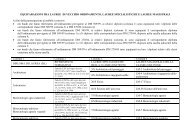
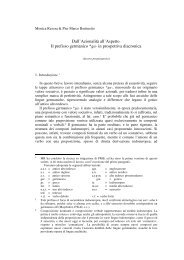
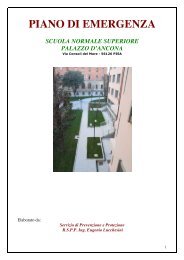
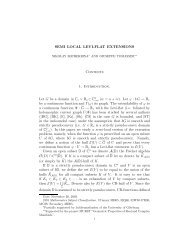
![4. Ghost [Å] vowels in French - Laboratorio di Linguistica](https://img.yumpu.com/49999334/1/184x260/4-ghost-a-vowels-in-french-laboratorio-di-linguistica.jpg?quality=85)


